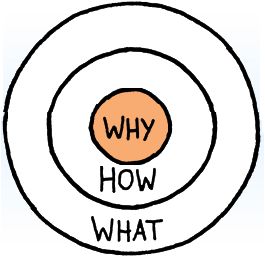As business-minded professionals, we love talking shop with other business leaders every day to understand what makes them tick. We’re also in the habit of sitting in on webinars, reading articles and blogs, and watching videos so that we can continue learn about what makes companies and organizations successful.
We wanted to share a video that really inspires us, one that is based around how great leaders inspire people to act (buy, vote, etc.). The piece is a TedX talk given by the renowned author, speaker, and business mind Simon Sinek.
While Simon, as well as this talk entitled “How Great Leaders Inspire Action” may be well-known, we like to share this important concept with the business owners we work with and advise because it truly hits home.
We invite you look watch this piece, and we’ve shared our accompanying thoughts below as well.
What do Apple, Martin Luther King, Jr., and the Wright Brothers have in common?
Sinek begins by mentioning these well-known people and brands to get our attention. He then goes further to tell us that their successes stem from a similar place.
He says that he discovered a pattern and strong comparison between Apple, with its powerful brand and sales history, Martin Luther King’s massive following, and Orville and Wilbur Wright’s invention of controlled powered-man flight.
His discovery was that these innovators thought, acted, and communicated in the same way – and it was the opposite of everyone else.
The Golden Circle
Sinek begins explaining this comparison by drawing what he calls the “Golden Circle.” He says that the contents of this circle explain why some leaders inspire and others don’t.

The circles elements include:
- What: All organizations know what they do.
- How: Many organizations know how they do it (proprietary processes, “secret sauces,” etc.)
- Why: Few organizations know why they do what they do.
An important note: Profit is NOT a part of “why,” but merely a result.
He goes on to explain that most people and organizations think from the outside in. Companies first tell you what they do, then how they do it and what makes them different, and only mention why they’re in business in a brief section on the “About” section of their website.
But, he says, great leadership works from the inside out. He uses the example of Apple. One of the most successful companies in history, Apple constantly talks about why they work so hard: to challenge the status quo and making people’s lives easier with user-friendly technology. The following they have created with this approach allows them as a computer company to sell music devices, TV-related equipment, and accessories because people believe in what they do.
By comparison, Dell and other quality technology companies have failed to replicate Apple’s model.
“People Don’t Buy What You Do, They Buy Why You Do It”
This phrase becomes Sinek’s mantra for the remainder of the talk. Piggybacking on the Apple example, he uses biology – not psychology – to explain why people get “gut feelings” and decide to buy based on what “feels right.”
He mentions that human brains are separated into three parts. The “new” brain, the neocortex, is responsible for rational thought. The other two limbic brains are in charge of feelings and decision-making, and language does not compute in these areas. By outlining the “why”, Sinek says, people and companies are speaking directly to the part of our brain responsible for acting – buying, voting, etc.
He also goes beyond the sales aspect. He advises the audience as business leaders to hire people who believe what you believe and believe in your “why”. Employees who believe in what you and the company believe in are more likely to pour their hearts and souls into their work, rather than just collecting a paycheck.
As example of this concept at work, he outlines how renowned inventor and aviation pioneer Samuel Pierpont Langley was commissioned by the U.S. government to develop powered man flight. Langley had access to substantial money, talent, and press, but was primarily interested in riches and fame.
The Wright Brothers became the ones to fly first, with none of Langley’s resources, because they – and the people that worked for them – believed that man-powered flight would change the world. The team was therefore more committed, and saw success faster as a result.
Law of Diffusion of Innovation
Sinek’s final thoughts address a law of which many business people are aware.
He talks about how the innovators and early adopters are the true believers in a product or company’s “why.” He also mentions that it’s these people that are needed to reach a tipping point of success, which is why communicating your beliefs as an entity is key.
As examples, he uses TiVo as a dramatic failure. Rather than speaking to each user’s ability to control their lives better, they focused on communicating features and functionality, expecting sale that never came.
As a successful example, he uses Martin Luther King, Jr.’s “I Have a Dream” speech. Over 250,000 people came to Washington, D.C. that day not for him, but for themselves. They believed in the cause, in his “why,” which was more powerful than just outlining a bulleted list of a plan like many politicians and activists use today.
Final Thoughts
Sinek is a brilliant business mind and a terrific speaker. The concept about leadership he outlines in this video is among the best motivational pieces we’ve found.
We share this video with all of the business leaders we work with, and hope that you find the talk helpful.
NOTE: These are the opinions of the author and not necessarily those of Cambridge; they are for informational purposes only, and should not be construed or acted upon as individualized investment advice.

No Comments